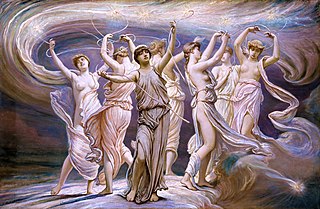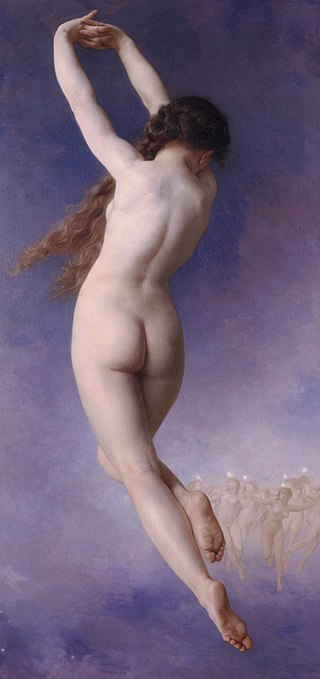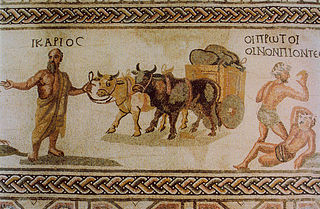
In Greek mythology, Ambrosia was one of the three or five Hyades. She was the sister of Aesyle (Phaesyle) and Eudora, [2] and Coronis and Polyxo.

In Greek mythology, Ambrosia was one of the three or five Hyades. She was the sister of Aesyle (Phaesyle) and Eudora, [2] and Coronis and Polyxo.
Dionysus was entrusted as a child to Ambrosia and her sisters, the Hyades. Later, Lycurgus assaulted the child Dionysus who was crossing his lands on Mount Nysa, escorted by the hyades. Lycurgus pursued and killed Ambrosia during this assault while her other sisters escaped and took refuge with Thetis. [3] As she died, she turned into a vine, trapping the murderer in her branches until the god returned.
According to another version, Ambrosia was one of the twelve daughters of Atlas and Pleione and one of five sisters (the Hyades, in Latin Sicule). [4] At the death of their only brother, Hyas, killed by a lion (or a boar), they cried so much that, according to myths, they either turned into stars or were transformed by the moved gods, thus becoming the constellation Hyades while their brother Hyas was transformed into the constellation Aquarius.

In Greek mythology, Callisto was a nymph, or the daughter of King Lycaon; the myth varies in such details. She was believed to be one of the followers of Artemis who attracted Zeus. Many versions of Callisto's story survive. According to some writers, Zeus transformed himself into the figure of Artemis to pursue Callisto, and she slept with him believing Zeus to be Artemis. She became pregnant and when this was eventually discovered, she was expelled from Artemis's group, after which a furious Hera, the wife of Zeus, transformed her into a bear, although in some versions Artemis is the one to give her an ursine form. Later, just as she was about to be killed by her son when he was hunting, she was set among the stars as Ursa Major by Zeus. She was the bear-mother of the Arcadians, through her son Arcas by Zeus.

In Greek mythology, Amalthea or Amaltheia is the most-frequently mentioned foster-mother of Zeus.

In Greek mythology, maenads were the female followers of Dionysus and the most significant members of the Thiasus, the god's retinue. Their name, which comes from μαίνομαι, literally translates as 'raving ones'. Maenads were known as Bassarids, Bacchae, or Bacchantes in Roman mythology after the penchant of the equivalent Roman god, Bacchus, to wear a bassaris or fox skin.

In Greek mythology, Agave, the daughter of Cadmus, was a princess of Thebes and the queen of the Maenads, followers of Dionysus.
In Greek mythology, Aethra or Aithra was a name applied to four different individuals:
Hyas, in Greek mythology, was a Boeotian who was regarded as the ancestor of the ancient Hyantes (Boeotians). His name means rain from hyô, hyetos.

In Greek mythology, Lycurgus was the king of the Edoni in Thrace, son of Dryas, the "oak", and father of a son whose name was also Dryas.

In Greek mythology, Electra was one of the Pleiades, the seven daughters of Atlas and Pleione. She lived on the island of Samothrace. She had two sons, Dardanus and Iasion, by Zeus.

The Pleiades, were the seven sister-nymphs, companions of Artemis, the goddess of the hunt. Together with their sisters, the Hyades, they were called the Atlantides, Dodonides, or Nysiades, nursemaids and teachers of the infant Dionysus. The Pleiades were thought to have been translated to the night sky as a cluster of stars, the Pleiades, and were associated with rain.
In Greek mythology, the Hyades are a sisterhood of nymphs that bring rain.
In Greek mythology, Maera was the hound of Erigone, daughter of Icarius of Athens.

In Greek mythology, Lycaon was a king of Arcadia who, in the most popular version of the myth, killed and cooked his son Nyctimus and served him to Zeus, to see whether the god was sufficiently all-knowing to recognize human flesh. Disgusted, Zeus transformed Lycaon into a wolf and killed his offspring; Nyctimus was restored to life.
In Greek mythology, Eudora or Eudore was a name given to three nymphs:
Polyxo is the name of several figures in Greek mythology:
Pleione was an Oceanid nymph in Greek mythology and mother of the Pleiades. Pleione presided over the multiplication of the flocks, fitting, since the meaning of her name is: "to increase in number".

In Greek mythology, Merope is one of the seven Pleiades, daughters of Atlas and Pleione. Pleione, their mother, is the daughter of Oceanus and Tethys and is the protector of sailors. Their transformation into the star cluster known as the Pleiades is the subject of various myths.

In Greek mythology, Erigone was the daughter of Icarius of Athens.

In Greek mythology, Icarius was a man from Athens who welcomed the god Dionysus.

In Greek mythology, Coronis is a Thessalian princess and a lover of the god Apollo. She was the daughter of Phlegyas, king of the Lapiths, and Cleophema. By Apollo she became the mother of Asclepius, the Greek god of medicine. While she was still pregnant, she cheated on Apollo with a mortal man named Ischys and was subsequently killed by the god for her betrayal. After failing to heal her, Apollo rescued their unborn child by performing a caesarean section. She was turned into a constellation after her death.
In Greek mythology, Aesyle, also called Phaesyle was one of the three or five Hyades, sisters that were rain-bringing nymphs. She was the sister of Eudora and Ambrosia, Polyxo and Coronis, and Cleeia and Phaeo. They were called the daughters of the Titan Atlas by either the Oceanids Aethra or Pleione, or of Hyas and Boeotia.